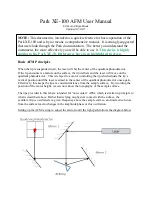
13
A15.0908 Series
◎
For Reflected Illumination
The changing direction of the aperture diaphragm is
as same as the field diaphragm, adjust its size by the
aperture diaphragm turntable
①
. Adjust the two
aperture diaphragm centering screws
②
, to move the
image of aperture diaphragm to the center of the
aperture (See Fig. 27).
◎
For Transmitted Illumination
Change the size of aperture diaphragm by turning the
aperture diaphragm adjusting ring
①
. (See Fig. 28).
Use of graduation: Put the N.A. of condenser to the
80% of the N.A
②
of objective.
3-11
Adjust the Analyzer
(1) Insert the analyzer flashboard
①
upward into the
socket of the intermediate lens group until to the
innermost, and the analyzer is shifted into the light
path. (See Fig. 29)
(2) Loosen the lock screw
④
, turn the analyzer
turntable
②
, to change the vibrated direction of the
analyzer. A grid value of scale is 2°, and the adjusting
range is 360°. When observed orthogonally, the “0”
reticle on turntable
②
should be leveled with the “0”
reticle on the vernier
③
. A grid value of vernier is 6
′
.
3-12
Adjust the Polarizer
◎
For Reflected Illumination
(1) Insert the polarizer flashboard
④
forward into the
socket of illumination system. The polarizer is moved
into the light path until two sounds of “KaDa” is
heard. (See Fig. 29)
◎
For Transmitted Illumination
(1) Turn the polarizer adjusting ring
①
, to adjust the
vibrated direction of the polarizer which is 360°
rotatable. When observed orthogonally, the “0” reticle
on adjusting ring should be leveled with the reticle on
the base. (See Fig. 30)
Fig.29
Fig.30
Fig.27
Fig.28
Summary of Contents for A15 0908 Series
Page 24: ......









































